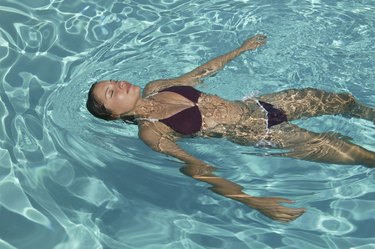
When you cannot walk due to injury or disability, losing weight can seem like a challenge. Instead of focusing on your limitations, consider all of the activities you can do just by using all of the strength in your upper body. Also realize that the type of exercise you do is just one component of weight loss. When you combine a proper diet with activities that allow you to make the most of your body, you will begin to lose weight even when you cannot walk.
Step 1
Exercise regularly. The Physical Activity Guidelines for Adults with Disabilities from the U.S. Department of Health and Human Services says that adults with disabilities—if able to—should be getting at least 75 minutes per week of vigorous aerobic activity, 150 minutes per week of moderate intensity activity, or a combination of both. To lose weight you may need to increase the amount of exercise you do. You can combine different forms of exercise to achieve the most benefits.
Video of the Day
Step 2
Eat fewer calories. You can't lose any weight if you eat back all of the calories that you burn. To lose a single pound you need to lose 3,500 calories. Divide this into one week, and you can lose a pound a week by cutting 500 calories from your diet every day. Don't eat less food, but replace high-calorie foods with filling fiber (such as fruits and vegetables) to stay full and keep your energy levels steady.
Step 3
Go swimming. Some forms of swimming require the use of your legs, so you may need to adopt techniques of adapted aquatics. Adapted aquatics modify general swimming techniques to your individual physical abilities. Adapted aquatics can also help you develop skills such as safely entering and exiting the pool.
Step 4
Play adaptive sports. You can get a lot of exercise that won't even feel like work if you find an adaptive sport that you enjoy. Aside from swimming, you can also take part in basketball, table tennis, track and field, handcycling, football, weight lifting, sled hockey and soccer. These sports are available to people who cannot walk because they adjust techniques and rules to their needs. Many adaptive sports are also made possible by specialty chairs that offer the necessary speed and mobility, such as racing wheelchairs, basketball wheelchairs, tennis wheelchairs and rugby wheelchairs.
Step 5
Exercise at the gym. One machine that is great for cardiovascular exercise is the crank bike (also called the arm bike). Instead of cranking the bicycle pedals with your feet, you pedal with your hands, increasing your heart rate and lean muscle mass. Gyms also offer upper body strength training options. For example, you can lift weights sitting on a stability ball. Get in touch with a personal trainer who can find safe gym exercises that are modified to your individual needs.
Video of the Day